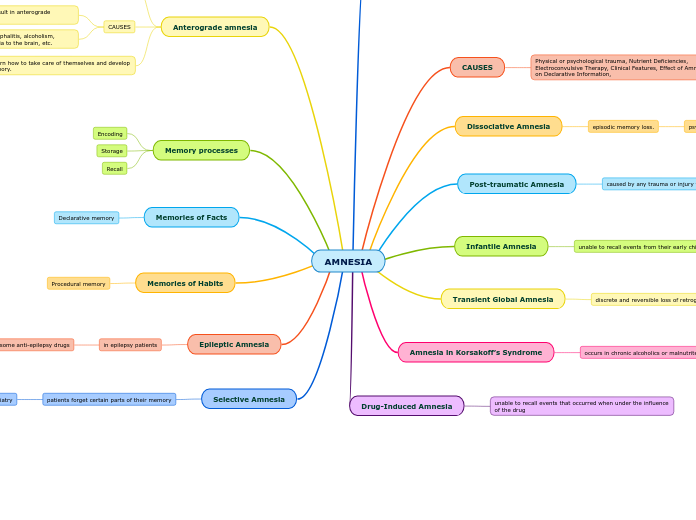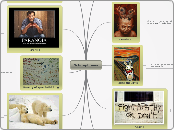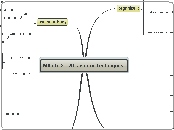Chapter 7: Memory
Most scientists believe that long-term potentiation; a gradual strengthening of the connections among neurons from repetitive stimulation plays a key role in the formation of memories and memory storage.
Amnesia
Case Study: H.M. and Clive Wearing
By far the best-known person with amnesia in psychological literature was a man from Connecticut known only by the initials H.M., who suffered from severe epileptic seizures that his doctors couldn’t control with medication.
In March 1953, in a last-ditch attempt to eliminate these seizures, surgeons removed large chunks of H.M.’s temporal lobes, including both his left and right hippocampi, where they had reason to believe the seizures originated.
At the time, H.M. was 26 years old. Following the operation, Brenda Milner from the Montreal Neurological Institute (MNI) discovered that H.M. had developed virtually complete anterograde amnesia: He couldn’t recall any new information. Although he also experienced some retrograde amnesia regarding the 11 years prior to the surgery, his memories from the first 15 years of his life remained pretty much intact.
H.M.’s life was, for all intents and purposes, frozen in time, “Every day is alone by itself, whatever enjoyment I have had, whatever sorrow I have had.”
H.M.’s true identity was revealed as Henry Molaison only after his death in December 2008 at the age of 82. For 55 years, he acquired virtually no new explicit memories. Still, at least one author has recently argued that H. M may have experienced damage to his frontal lobes during surgery, raising the possibility that his hippocampal damage may not fully explain his severe memory impairment
Although many Hollywood films depict memory recovery from amnesia as abrupt, recovery from amnesia tends to occur gradually, if at all.
Much more frequent among people with brain damage.
Generalized amnesia: In which people have lost all details of their previous life, is quite rare.
Anterograde amnesia: In which we lose the capacity to form new memories.
Retrograde amnesia: In which we lose some memories of our past.
Isn’t especially common.
Where is Memory Stored?
Functional magnetic resonance imaging (fMRI) studies reveal that learned information isn’t stored permanently in the hippocampus itself. Rather, the prefrontal cortex seems to be one of the major “banks” from which we withdraw our memories
Lashley discovered that damage to isolated areas of the prefrontal cortex doesn’t wipe out long-established memories.
The hippocampus is critical to memory.
One source of evidence for the role of the hippocampus in memory comes from research on Clark’s nutcracker, a remarkable North American bird. To help it prepare for long winters, Clark’s nutcracker buries up to 33 000 seeds in about 5000 places spread over about 150 square miles—and manages to locate most of them months later—even though they’re often buried under several feet of snow!
Clark’s nutcracker has an unusually large hippocampus, which may help to explain its exceptional spatial memory.
Long-term potentiation (LTP) refers to a long-lasting strengthening of the connections between two neurons after synchronous activation
Long-Term Depression
long-term depression (LTD): Synapses in neuronal networks can be strengthened by LTP, and a similar but opposite process.
LTD occurs due to repeated low-frequency patterns of activation of synaptically connected neurons, resulting in less “wiring together.” If we only had the process of LTP occurring in the nervous system, it would eventually meet a maximal point at which no more learning could occur.
The process of LTD acts to balance out LTP and helps synaptic connections reset, which allows for the constant updating and encoding of new information.
LTD has been studied less than LTP, but has been found in many areas of the brain, including the hippocampus and neocortex.
LTP and Glutamate
LTP tends to occur at synapses where the sending neuron releases the neurotransmitter glutamate into the synaptic cleft—the space between the sending and receiving neuron.
LTP enhances the release of glutamate into the synaptic cleft, resulting in enhanced learning
A research team was even able to create a “super smart mouse” by manipulating its genes to create extra receptors for NMDA. Compared with everyday mice, the super smart mouse is an especially quick and effective learner.
LTP and The Hippocampus
To tell what cells are responsible for LTP, many researchers use thin slices of the hippocampus. These slices come from young animals, usually rats or mice, and are bathed in solutions containing nutrients that keep the tissue alive.
In a typical LTP experiment, researchers first establish how hippocampal cells respond at baseline. This is much like determining how we respond to someone asking us a question. Researchers then apply a strong stimulus, much like having someone yell at us. After the strong stimulus, hippocampal neurons respond at an enhanced level to ordinary stimuli, much as we might respond to a neutral question with a louder voice than usual after someone yelled at us. That’s LTP.
LTP was first recorded in the hippocampus of an anesthetized rabbit in 1973, and recently has been observed in live human brains from tissue samples that were removed to treat epilepsy
Today, many researchers believe that our ability to store memories depends on strengthening the connections among neurons arranged in sprawling networks that extend to the far and deep recesses of our brains
The gist of what neuroscientists have learned since the discovery of LTP is that neurons that “fire together wire together”
Terje Lomo first observed LTP in the hippocampus of rabbits in 1966, and researchers have since identified it in the hippocampus and other brain structures of humans, other mammals, and even some invertebrates
Memory is the retention of information over time, they can be surprisingly accurate over very long periods of time, but tend to be reconstructive rather than reproductive.
Memories of a small subset of individuals with a condition known as infantile autism are quite amazing.
Kim Peek, an individual with Infantile Autism, IQ was 87, yet he memorized about 12 000 books word for words, the ZIP codes of every town in the United States, and the number of every highway connecting every city in the United States.
Paradox of Memory: Our memories are surprisingly in some situations and surprisingly poor in others, The same memory mechanisms that serve us well in most circumstances can sometimes cause us problems in others.
Schemas provide one key explanation for the paradox of memory: They enhance memory in some cases but lead to memory errors in others.
The fact that we’re receptive to suggestions about whether and how events took place bears important implications for children’s memory and eyewitness testimony. Many scientists have argued that apparent “recovered memories” of early trauma may be due to the tendency of suggestive therapeutic procedures to induce false recollections.
Flashbulb memories seem more crisp and vivid than do other memories, but may be just as vulnerable to errors as other kinds of memory. One source of memory errors is source monitoring difficulty; we can’t always remember where we learned something or whether it was a figment of our imagination, sometimes resulting in cryptomnesia. Our memories for events are easily influenced by suggestions from others.
Both infants' and children's memories are influenced by some of the same factors as adults' memory. Children's memory improves in part because of maturational changes in the brain that extend the span of memory. Over time, children become better able to use mnemonic and rehearsal strategies and become more aware of their memory limitations.
The memory loss of patients with Alzheimer's disease begins with that of recent events, with memories of events of the distant past typically being the last to go. Alzheimer's disease is marked by loss of synapses and acetylcholine neurons.
Evidence from studies of patients with amnesia demonstrates the there are distinct memory systems because people with amnesia for declarative memory often still form new procedural memories. Retrograde amnesia causes forgetting of past experiences, whereas retrograde amnesia prevents us from forming memories of new experiences.
Individuals tend to remember better if they're tested under the same physical and emotional conditions as when they encoded the information.
Recall requires generating previously encountered information on our own, recognition simply requires selecting the correct information from an array of choices. How quickly we relearn material previously learned and forgotten provides another measure of memory.
Relearning: A third way of measuring memory, it is how much more quickly we learn information when we study something we’ve already studied relative to when we studied it the first time. For this reason, psychologists often call this approach the method of savings.
Recognition: Selecting previously remembered information from an array of options
Recall: Generating previously remembered information on our own
Why is recall usually harder than recognition? In part, it’s because recalling an item requires two steps—generating an answer and then determining whether it seems correct—whereas recognizing an item takes only one step: determining which item from a list seems most correct
Retrieval, the third and final process of memory is many of us want to improve our memory. To remember something, we need to fetch it from our long-term memory banks.
Schemas equip us with frames of reference for interpreting new situations. Nevertheless, they can sometimes lead to memory errors.
Schemas simplify, which is good because they help to make sense of the world. But schemas sometimes oversimplify, which is bad because they can produce memory illusions.
Schemas can sometimes create problems for us because they can lead us to remember things that never happened
Without schemas, we’d find some information almost impossible to comprehend
Schemas serve a valuable function: They equip us with frames of reference for interpreting new situations.
A schema is an organized knowledge structure or mental model that we’ve stored in memory. Our schema for restaurants is characterized by a set order of events, sometimes called a script.
Storage refers to the process of keeping information in memory.
Mnemonics are memory aids that link new information to more familiar knowledge. there are many kinds of mnemonics; they take effort to use but can assist recall.
Mnemonic: a learning aid, strategy, or device that enhances recall.
Mnemonics can be helpful if we’re motivated to practice them on a regular basis. Many people seem to prefer external aids, such as making lists
One pair of researchers set out to determine if putting material to be learned to a familiar melody like “Pop Goes the Weasel” or “Yankee Doodle Dandy” can assist in learning. They included lists of names in the two songs, and participants either listened to one or the other tune or heard the words in the lists spoken.
The researchers found no initial recall advantage for people who learned the names with musical accompaniment. However, those who heard the sung version required fewer trials to relearn the names a week later, suggesting that learning information put to a melody improves long-term retention.
If you’ve taken a foreign language course, you may be familiar with the keyword method. If you’ve taken a foreign language course, you may be familiar with the keyword method.
Researchers have found that the keyword strategy was effective for third-graders, including students with learning disabilities, in mastering new vocabulary words
Take the Spanish word casa, which means “house” in English. Think of an English word, like case, that sounds like or brings to mind casa. Now think of an image that combines case and house.When you think of this image, it should help you retrieve the meaning of casa.
People who learn foreign vocabulary benefit from the keyword strategy compared with more traditional methods, such as rote memorization.
The method of loci (pronounced “low-sigh”) relies on imagery of places—that is, locations, hence the name of the mnemonic
The method is; Think of a path with which you are familiar and can imagine vividly. Perhaps it’s the route from your dorm to the cafeteria, or a stroll through the rooms in your apartment. Think of the path you take and the things you encounter in a set order.
Researchers have used the method of loci to help depressed individuals recall positive, self-affirming memories to lift their mood
e.g: to get to the cafeteria, first you get in the elevator, then you walk under a huge tree before you pass by a fountain, and so on. If you need to remember five words in a particular order, think of five things you’ll encounter on your way to the cafeteria.
Rhyming is a key component of the pegword method, often used to recall lists of words.
e.g: songs ranging from “Twinkle, Twinkle Little Star” to the hip-hop songs of Drake are easy to remember because they contain rhymes.
To master the pegword method, first associate each number in a list with a word that rhymes with each number, such as “One is a bun.” The word associated with the number is a “pegword.” It’s essential to the method to memorize a list like the one that follows, but the fact that the numbers and words rhyme makes it easy to do so.
e.g: (1) One is a bun, (2) Two is a shoe, (3) Three is a tree, and (4) Four is a door.
Mnemonics differ from these “external” memory aids in that they rely on internal mental strategies—namely, strategies we use during encoding that help us later retrieve useful information.
Mnemonics help us encode memories in a way that makes them easier to recall. All of us use recall boosters; making lists or writing appointments on a calendar, cell phone, or laptop
e.g: Picture yourself working as a librarian at your college or university library. When a new book arrives, you first give it a number to identify it; that’s encoding. Then you file it away on the bookshelf; that’s storage. Then, when you want to find the book a few weeks, months, or even years later, you go to the shelves and fetch it; that’s retrieval.
There are three major processes of memory: encoding, storage, and retrieval.
Encoding refers to the process of getting information into our memory.
Encoding also helps to explain the familiar next-in-line effect.
You’ve experienced this phenomenon if you’ve ever been in a class when the instructor called on several students in a row to answer a question or say their names.
Most events we’ve experienced are never encoded, and almost all events we do encode include only some of the details of the experience.
To encode something, we must first attend to it.
Once we lose the chance to encode an event, we’ll never remember it. No encoding, no memory.
The three systems refer to the what of memory, the three processes we’re about to discuss refer to the how of memory. They explain how information gets transferred into long-term memory and gets back out again when we need it.
Explicit memory subtypes include semantic and episodic memory. Implicit memory types include procedural and priming memory.
Sensory memory, short-term memory, and long term memory are stages of information processes that differ in how much information they hold/how long they retain it.









